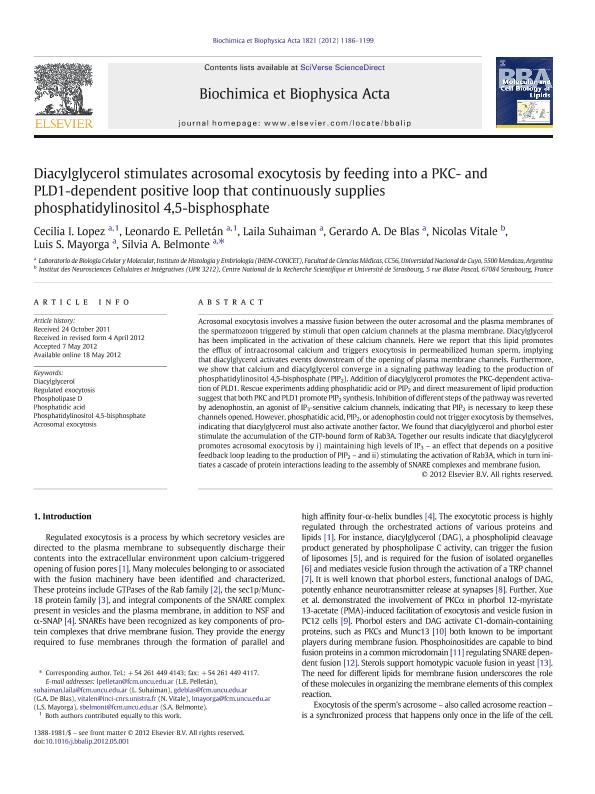Mostrar el registro sencillo del ítem
dc.contributor.author
Lopez, Cecilia Ines

dc.contributor.author
Pelletán, Leonardo Enuar

dc.contributor.author
Suhaiman, Laila

dc.contributor.author
de Blas, Gerardo Andrés

dc.contributor.author
Vitale, Nicolas

dc.contributor.author
Mayorga, Luis Segundo

dc.contributor.author
Belmonte, Silvia Alejandra

dc.date.available
2021-10-25T18:06:33Z
dc.date.issued
2012-09
dc.identifier.citation
Lopez, Cecilia Ines; Pelletán, Leonardo Enuar; Suhaiman, Laila; de Blas, Gerardo Andrés; Vitale, Nicolas; et al.; Diacylglycerol stimulates acrosomal exocytosis by feeding into a PKC- and PLD1-dependent positive loop that continuously supplies phosphatidylinositol 4,5-bisphosphate; Elsevier Science; Biochimica Et Biophysica Acta - Molecular and Cell Biology of Lipids; 1821; 9; 9-2012; 1186-1199
dc.identifier.issn
1388-1981
dc.identifier.uri
http://hdl.handle.net/11336/144976
dc.description.abstract
Acrosomal exocytosis involves a massive fusion between the outer acrosomal and the plasma membranes of the spermatozoon triggered by stimuli that open calcium channels at the plasma membrane. Diacylglycerol has been implicated in the activation of these calcium channels. Here we report that this lipid promotes the efflux of intraacrosomal calcium and triggers exocytosis in permeabilized human sperm, implying that diacylglycerol activates events downstream of the opening of plasma membrane channels. Furthermore, we show that calcium and diacylglycerol converge in a signaling pathway leading to the production of phosphatidylinositol 4,5-bisphosphate (PIP2). Addition of diacylglycerol promotes the PKC-dependent activation of PLD1. Rescue experiments adding phosphatidic acid or PIP2 and direct measurement of lipid production suggest that both PKC and PLD1 promote PIP2 synthesis. Inhibition of different steps of the pathway was reverted by adenophostin, an agonist of IP3-sensitive calcium channels, indicating that PIP2 is necessary to keep these channels opened. However, phosphatidic acid, PIP2, or adenophostin could not trigger exocytosis by themselves, indicating that diacylglycerol must also activate another factor. We found that diacylglycerol and phorbol ester stimulate the accumulation of the GTP-bound form of Rab3A. Together our results indicate that diacylglycerol promotes acrosomal exocytosis by i) maintaining high levels of IP3 – an effect that depends on a positive feedback loop leading to the production of PIP2 – and ii) stimulating the activation of Rab3A, which in turn initiates a cascade of protein interactions leading to the assembly of SNARE complexes and membrane fusion.
dc.format
application/pdf
dc.language.iso
eng
dc.publisher
Elsevier Science

dc.rights
info:eu-repo/semantics/openAccess
dc.rights.uri
https://creativecommons.org/licenses/by-nc-sa/2.5/ar/
dc.subject
ACROSOMAL EXOCYTOSIS
dc.subject
DIACYLGLYCEROL
dc.subject
PHOSPHATIDIC ACID
dc.subject
PHOSPHATIDYLINOSITOL 4,5-BISPHOSPHATE
dc.subject
PHOSPHOLIPASE D
dc.subject
REGULATED EXOCYTOSIS
dc.subject.classification
Bioquímica y Biología Molecular

dc.subject.classification
Medicina Básica

dc.subject.classification
CIENCIAS MÉDICAS Y DE LA SALUD

dc.title
Diacylglycerol stimulates acrosomal exocytosis by feeding into a PKC- and PLD1-dependent positive loop that continuously supplies phosphatidylinositol 4,5-bisphosphate
dc.type
info:eu-repo/semantics/article
dc.type
info:ar-repo/semantics/artículo
dc.type
info:eu-repo/semantics/publishedVersion
dc.date.updated
2021-04-28T20:14:06Z
dc.journal.volume
1821
dc.journal.number
9
dc.journal.pagination
1186-1199
dc.journal.pais
Países Bajos

dc.journal.ciudad
Amsterdam
dc.description.fil
Fil: Lopez, Cecilia Ines. Universidad Nacional de Cuyo. Facultad de Ciencias Médicas. Instituto de Histología y Embriología; Argentina. Consejo Nacional de Investigaciones Científicas y Técnicas. Centro Científico Tecnológico Conicet - Mendoza; Argentina
dc.description.fil
Fil: Pelletán, Leonardo Enuar. Universidad Nacional de Cuyo. Facultad de Ciencias Médicas. Instituto de Histología y Embriología; Argentina. Consejo Nacional de Investigaciones Científicas y Técnicas. Centro Científico Tecnológico Conicet - Mendoza; Argentina
dc.description.fil
Fil: Suhaiman, Laila. Universidad Nacional de Cuyo. Facultad de Ciencias Médicas. Instituto de Histología y Embriología; Argentina. Consejo Nacional de Investigaciones Científicas y Técnicas. Centro Científico Tecnológico Conicet - Mendoza; Argentina
dc.description.fil
Fil: de Blas, Gerardo Andrés. Consejo Nacional de Investigaciones Científicas y Técnicas. Centro Científico Tecnológico Conicet - Mendoza. Instituto de Histología y Embriología de Mendoza Dr. Mario H. Burgos. Universidad Nacional de Cuyo. Facultad de Ciencias Médicas. Instituto de Histología y Embriología de Mendoza Dr. Mario H. Burgos; Argentina
dc.description.fil
Fil: Vitale, Nicolas. Université de Strasbourg; Francia. Centre National de la Recherche Scientifique; Francia
dc.description.fil
Fil: Mayorga, Luis Segundo. Consejo Nacional de Investigaciones Científicas y Técnicas. Centro Científico Tecnológico Conicet - Mendoza. Instituto de Histología y Embriología de Mendoza Dr. Mario H. Burgos. Universidad Nacional de Cuyo. Facultad de Ciencias Médicas. Instituto de Histología y Embriología de Mendoza Dr. Mario H. Burgos; Argentina
dc.description.fil
Fil: Belmonte, Silvia Alejandra. Consejo Nacional de Investigaciones Científicas y Técnicas. Centro Científico Tecnológico Conicet - Mendoza. Instituto de Histología y Embriología de Mendoza Dr. Mario H. Burgos. Universidad Nacional de Cuyo. Facultad de Ciencias Médicas. Instituto de Histología y Embriología de Mendoza Dr. Mario H. Burgos; Argentina
dc.journal.title
Biochimica Et Biophysica Acta - Molecular and Cell Biology of Lipids

dc.relation.alternativeid
info:eu-repo/semantics/altIdentifier/doi/http://dx.doi.org/10.1016/j.bbalip.2012.05.001
dc.relation.alternativeid
info:eu-repo/semantics/altIdentifier/url/https://www.sciencedirect.com/science/article/abs/pii/S138819811200090X
Archivos asociados
